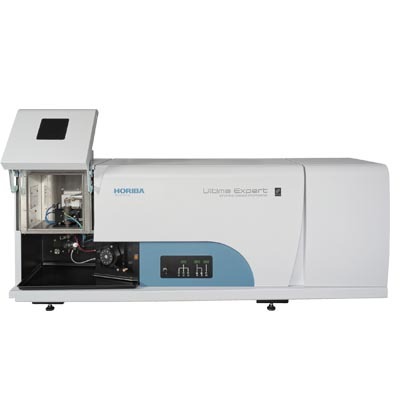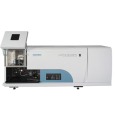方案详情
文
ICP-OES is a multi-element technique that allows the determination of 75 elements in the periodic table. One element that is desirable to analyze at the same time as other elements is chlorine.
However, until recently, the analysis of halogens,especially chlorine, was usually not undertaken by ICP. This was because the halogens are not easy to excite in a plasma source and their emission
wavelengths are challenging for conventional optics. Chlorine wavelengths, which yield good sensitivity, are low (133 nm and 134 nm) and are not possible to measure with conventional solidstate
detectors or photomultiplier tubes.
This Application Note describes recent hardware improvements that allow the determination of Cl,Br and I by ICP-OES.
方案详情

ICP OPTICAL EMISSION SPECTROSCOPYAPPLICATION NOTE 10 Analysis of Chlorine, Bromine and lodine in Water using ICP-OESJobin Yvon S.A.S., Horiba Group Longjumeau, France 1 Introduction ICP-OES is a multi-element technique that allowsthe determination of 75 elements in the periodictable. One element that is desirable to analyze atthe same time as other elements is chlorine.However, until recently, the analysis of halogens,especially chlorine, was usually not undertakenby ICP. This was because the halogens are noteasy to excite in a plasma source and their emis-sion wavelengths are challenging for convention-al optics. Chlorine wavelengths, which yield goodsensitivity, are low (133 nm and 134 nm) and arenot possible to measure with conventional solid-state detectors or photomultiplier tubes. This Application Note describes recent hardwareimprovements that allow the determination of Cl,Br and l by ICP-OES 2 Principle 2.1 Technique used The elemental analysis of solutions was under-taken by Inductively Coupled Plasma OpticalEmission Spectrometry (ICP-OES). The sample isnebulized then transferred to an argon plasma. Itis decomposed, atomized and ionized wherebythe atoms and ions are excited. We measure theintensity of the light emitted when the atoms orions return to lower levels of energy.y.EEach ele-ment emits light at characteristic wavelengthsand these lines can be used for quantitativeanalysis after a calibration. 2.2 Wavelength choice The choice of the wavelength in a given matrixcan be made using the “profile"function, or byusing Win-IMAGE, which is rapid semi-quantita-tive analysis mode using multiple wavelengths.The principle is the same in either case: recordthe scans of analytes at low concentration, and of the matrix. By superimposing the spectra, wesee possible interferences. 2.3 Limits of detection estimation The limits of detection are calculated using thefollowing formula: LOD = k x BEC x RSDo With: LOD = limits of detection, k= 3 for the normal 3-sigma values, BEC = Background equivalent concentration, RSDo = relative standard deviation of the blank. To calculate the LOD, a calibration curve is con-structed using two points, 0 ppm and 5 ppm, orsome concentration where the calibration is lin-ear; this gives the BEC. The RSDo is evaluated byrunning the blank ten times. 3 Sample preparation Standards were prepared by dilution of 1,000ug/ml single-element solutions with deionizedwater. The standards are made from NaCl, KBrand Kl and are available from Spex Certiprep. 4 Instrument specification The work was done on a JY ULTIMA. The speci-fications of this instrument are listed in Table 1and2. www.certiprep.com Table 1: Specification of spectrometer Parameters Specifications Mounting Czerny Turner Focal length 1 m Thermoregulation Yes Nitrogen purge Yes Grating number of grooves 2400 gr/mm 1st order resolution 0.010 nm 2nd order resolution 0.005 nm Order 2nd order Table 2: Specification of RF Generator Parameters Specifications Type of generator Solid state Observation Radial Frequency 40.68 MHz Control of gas flowrate By computer Control of pump flow By computer Cooling Air 5 Operating conditions The operating conditions are listed in Table 3 below. Table 3: Operating conditions Parameter Condition RF Generator power 1000 W Plasma gas flowrate 12 L/min Auxiliary gas flowrate O L/min Sheath gas flowrate 0.2 L/min Nebulizer gas flowrate 1.2 L/min Nebulizer flowrate 3 bars (45 psi) Sample uptake 1 mL/min Type of nebulizer Concentric Type of spray chamber Cyclonic Argon humidifier Yes Injector tube diameter 3.0 mm The line with the highest sensitivity was used foreach of the elements, as there were no interferenceproblems. The conditions were the same for all ele- ments. Table 4: Analysis conditions Element Slits Analysis Integration um Mode Time (sec) 16 This instrument implemented the use of a specialadaptation that allows the detection of very lowwavelengths. The adaptation consists of a specialPMT with a CaF2 window, which has good effi-ciency below 200 nm, and special CaF2 optics thattransmit low UV light. With this adaptation, thespectral range is 120 -800 nm. 7.1 Calibration curve A calibration curve was made with four points, withthe concentrations of the standards presented inTable 5. Table 5: Standard concentrations Elements Concentration in mg/L CI 0, 5, 10,50 Br 0, 5, 10, 50 O, 1.27,12.7,127 Calibration curves are presented on the followingpage in Figure 1. 7.2 Scans Scans of solutions used for calibration were used toobtain profiles. They are presented on page 4 inFigure 2. Calibration 1st ordor: 7030.03 Figure 1: Calibration curves The limits of detection were calculated using theformula given in Section 2.3 and are given in thetable below. Table 6: Limits of Detection ElementWavelength BEC LOD (nm) (ug/L) (ug/L) CI 134.72 3400 300 Br 163.34 3350 170 179.85 350 20 182.98 850 8 The analysis of Br, Cl and I is possible with ICP-OESat low limits of detection due to an adaptation ofthe instrument. This adaptation doesn't affect thedetermination of other elements and will generallyimprove analytical performance for any elementallines below 200 nm for example, Pb at 168 nm. CE In the USA:Jobin Yvon Inc.3880 Park AvenueEdison, NJ 08820Tel: 1-732-494-8660Fax: 1-732-494-8796E-mail:emission@jyhoriba.com
确定


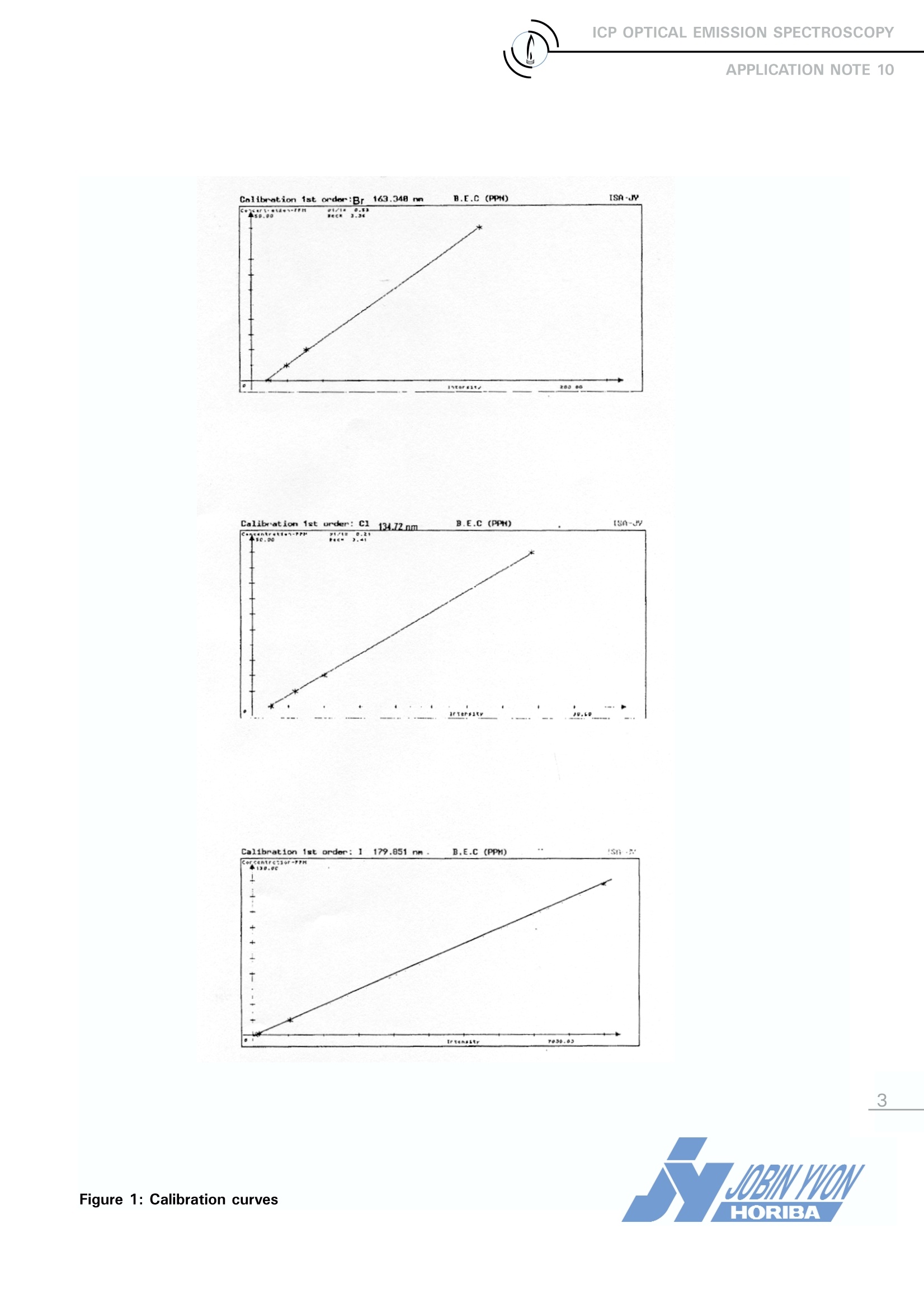
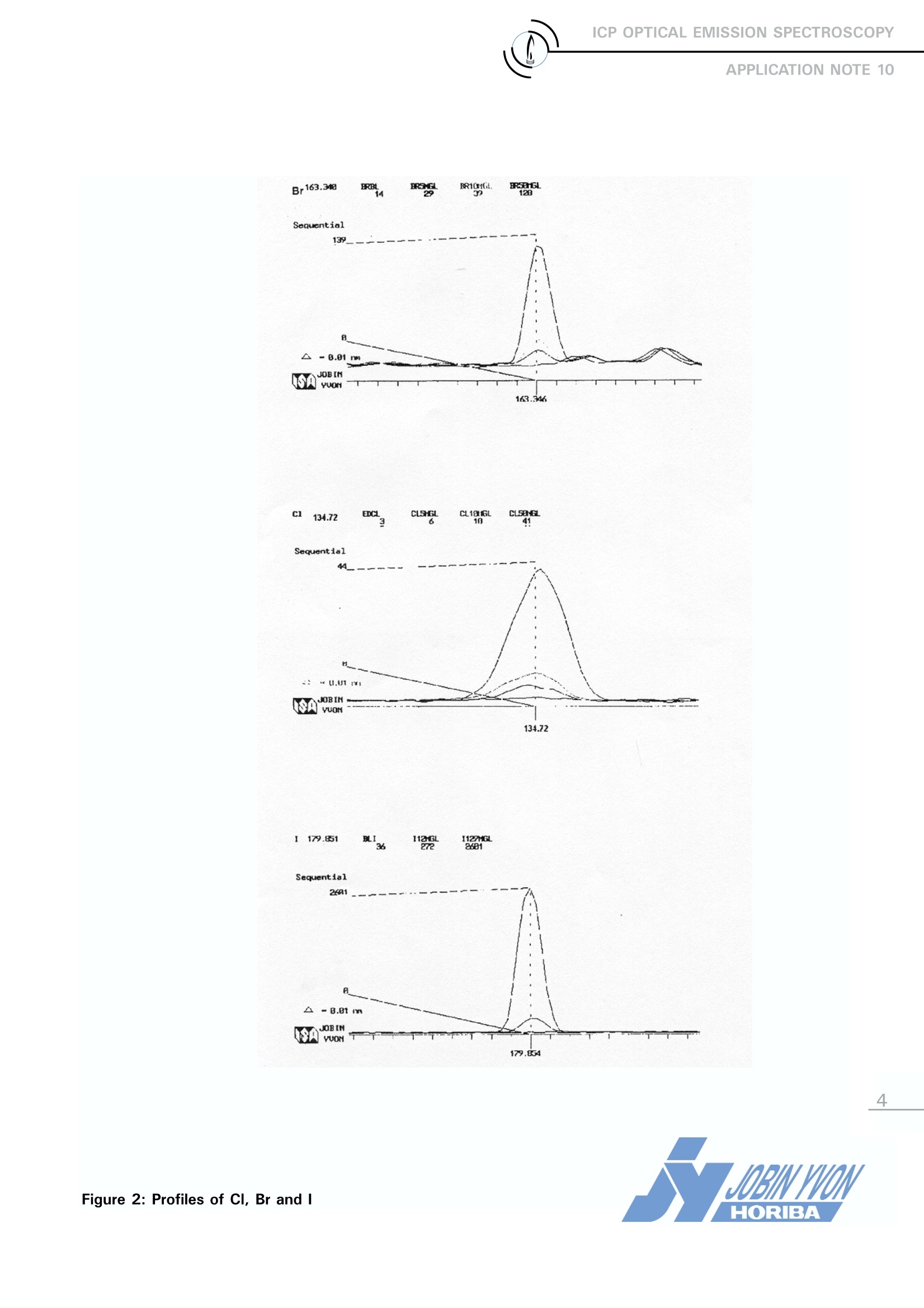
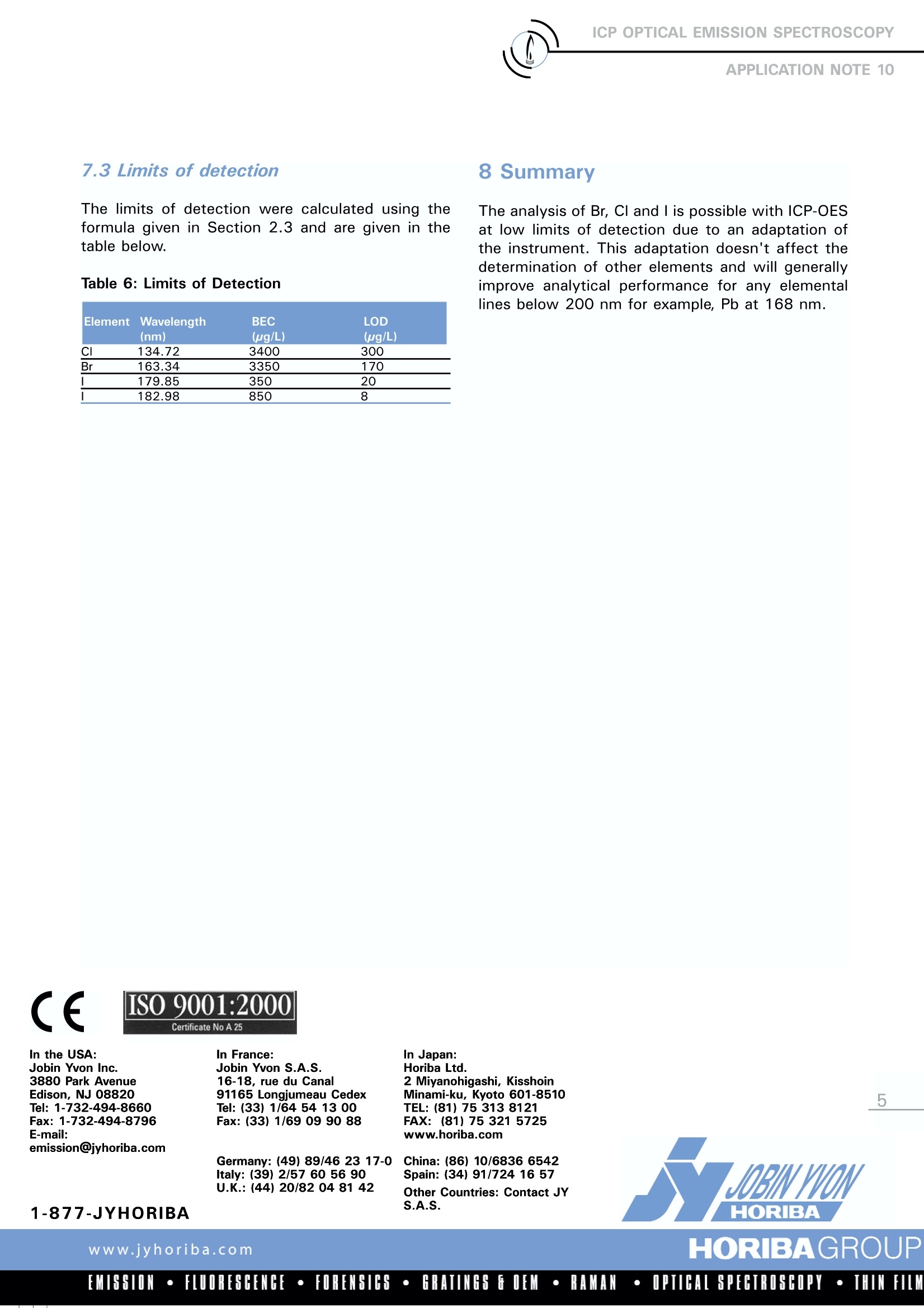
还剩3页未读,是否继续阅读?
HORIBA(中国)为您提供《环境水中氯离子检测方案(ICP-AES)》,该方案主要用于环境水(除海水)中氯离子检测,参考标准--,《环境水中氯离子检测方案(ICP-AES)》用到的仪器有HORIBA Ultima Expert高性能ICP光谱仪
相关方案
更多
该厂商其他方案
更多

